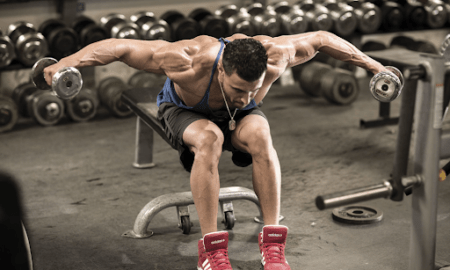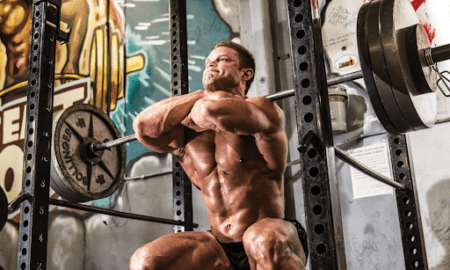Q: I’m 16, and I lift weights and exercise. I get stronger, but I can’t lose weight. I’m 5’9” and weigh 255 pounds. I want to join the Army but can’t meet the weight requirement. I need some tips on what my diet should consist of, which workouts to do more of and if there are any I shouldn’t do. I eat two meals a day for about 1,700 calories. I eat just about anything I want to, but I don’t eat junk food.
A: Losing bodyfat and weight is all about the diet. For most people who can’t lose weight, it’s because they are eating both the wrong foods and too much of them; however, it’s also possible to not eat enough.
The key to getting lean and staying lean is to increase your metabolism. When the metabolism is ramped up, the body will burn more calories at a faster rate, and it will be easier to maintain a lean physique.
A slower metabolism will encourage fat deposition, which will cause the metabolism to become even slower. You need to get on the right track to losing stored bodyfat. As you become leaner, your metabolism will begin to increase and you will lose fat at a faster rate.
You’re on the right track by doing resistance training. Lifting weights will help you to develop muscle tissue. The more muscle you have, the faster your metabolism will become. Muscle is active tissue. It requires energy to sustain it. Fat, on the other hand, is inactive. It takes up space on the body and slows the metabolism down.
By developing more muscle tissue, you will speed up your metabolism and take the first step toward becoming leaner. You mentioned that you’re getting stronger, but you can’t lose weight. It’s possible that you’re training more for strength than muscle development.
When you train with very heavy resistance, limiting your repetitions to less than six per set, you’re building the tendon and ligament strength of your muscle attachments more than the muscle tissue itself. Using slightly higher repetitions—eight to 12—with less weight will build more muscle tissue. The higher reps will pump more blood into the muscle and promote more growth than fewer reps and more weight.
When your goal is to reduce your bodyweight, it’s also a good idea to increase the number of exercises and sets to burn more calories than a shorter workout with fewer exercises and sets.
Cardiovascular training will also help to burn calories and stored bodyfat. You can use cardio to help accomplish both goals. Many bodybuilders use cardio workouts conservatively because they want to burn bodyfat but still maintain their muscle. In order to accomplish that goal, it’s important to find the right balance.
In your case, you can do a lot of cardio because your main goal is to lose weight in order to join the Army. I recommend that you do cardio at least five days a week. You can do a combination of high-intensity-interval training and regular steady-state cardio. Both types will burn calories, but the HIIT cardio is more intense, so it will use more calories than the less-intense steady-state training.
If you did your weight-training workout four days a week, you could combine that with five days of cardio training. That would allow you to build muscle tissue, burn bodyfat and not overtrain by working out too much. No matter how many calories you’re trying to burn or how much weight you want to lose, you still need to recuperate to avoid injuries and overtraining.
Here is an example of a weight-training program you can use to stimulate muscle growth and burn calories. I recommend that you split your muscle groups over two days and train each bodypart twice a week.
Monday & Thursday
Dumbbell bench presses 4 x 8-10
Incline presses 3 x 8-10
Flat-bench flyes 3 x 8-10
Wide-grip pulldowns 3 x 8-10
Barbell bent-over rows 4 x 6-10
Seated cable rows 3 x 8-10
Deadlifts 3 x 6-10
Seated dumbbell presses 3 x 8-10
Barbell upright rows 3 x 8-10
Seated bent-over lateral raises 3 x 8-10
Leg press calf raises 4 x 12-15
Tuesday & Friday
Incline situps 3 x 25
Hanging knee raises 3 x 25
Leg extensions 3 x 12-15
Barbell squats 4 x 8-12
Dumbbell lunges 3 x 10
Leg curls 3 x 8-12
Stiff-legged deadlifts 3 x 8-10
Pushdowns 3 x 8-12
Lying extensions 3 x 8-10
Seated dumbbell curls 3 x 8-10
Barbell curls 3 x 8-10
For your cardio workouts do at least 30 minutes of steady-state cardio on the treadmill using a high incline immediately after your weight workouts four days a week. Doing cardio after weight training will help to burn more bodyfat because you will have used up most of your glycogen supply during your anaerobic, weight-training workout. Your body will have to use stored fat for energy in the absence of the carbohydrate, so this is the ideal time to perform cardio.
On two of your off days from your weight workouts, do the HIIT cardio, in which you alternate a faster speed with a lower speed to increase the intensity. This form of cardio has been shown to increase your metabolism for a longer period after the workout is over. It also burns more calories during the training session.
You can use the HIIT technique with any form of cardiovascular training. For example, you can run for 30 seconds followed by a 60 second walk or increase the speed on the treadmill for two minutes followed by a two-minute walk. I like using the StairMaster for HIIT training, increasing the speed for two minutes and reducing it for two minutes. Doing that type of workout for 20 to 30 minutes will burn a lot of calories.
Now let’s talk about the most important part of the equation: your diet. What you eat and what you don’t eat will have a greater impact on how much fat you store on your body than anything else. It’s critical to eat the right types of foods in the right amounts and at the right times during the day to get the fat-burning process going.
You mentioned that you eat 1,700 calories a day, but that you only eat two meals a day. That’s the first thing you should change. By eating only two meals per day, you are encouraging your metabolism to slow down. Every time you eat, your body has to expend calories to digest it, and that increases your metabolism.
Another important point about eating multiple meals throughout the day as opposed to only two or three is your blood sugar. When you don’t eat for several hours, your blood sugar drops. The lower the blood sugar becomes, the greater it will spike when you eat your next meal. A rapid rise in blood sugar will force the body to release insulin to manage all the sugar.
When that happens, those calories are transported into your fat cells. That’s the reason it’s important to keep your blood sugar stable and not allow it to get too low or too high. Eating small meals every three hours will help give your body the nutrients it needs and keep the blood sugar stable.
You can figure out what you need to eat by looking at the three macronutrients. Protein is responsible for muscle growth and development, so it’s important that you eat enough complete protein foods with each meal.
If you weigh 255 pounds, I suggest you eat at least 225 grams of protein per day. Eat lowfat protein foods like egg whites, turkey, chicken and fish. Eat six meals a day, with each containing 35 to 40 grams of protein.
You will also need complex carbohydrates for energy and to help repair the muscles after your workouts. Stay away from simple sugars like processed foods, fruit juices and soda, and eat complex carbs that are digested slowly and contain lots of fiber. Foods such as oatmeal, oat bran, sweet potatoes, brown rice and Ezekiel bread as well as vegetables such as broccoli, asparagus and green beans will give your body the energy it needs for your tough workouts but will not create a rise in blood sugar the way simple sugars will.
I think you can start out eating about 180 grams of carbohydrates a day to help stimulate your metabolism and give you the energy you need. Many people like eating a very low-carb diet, but you will need the carbs to help you get through your weight-training and cardio workouts.
If you can keep your total fat intake to about 50 grams per day, your total calorie intake will come out to a little more than 2,000 per day. The key is to eat the right foods and eat six meals a day instead of only two. That will keep your metabolism going fast and help you to begin the fat-burning process. Good Luck!
Editor’s note: John Hansen has won the Mr. Natural Olympia and is a two-time Natural Mr. Universe winner. Check out his Web site at www.NaturalOlympia.com for more information about how you can be a part of his exciting, new Natural Olympia Fitness getaway. Send questions or comments to [email protected]. Look for John’s DVD, “Natural Bodybuilding Seminar and Competitions,” along with his book, Natural Bodybuilding, and his training DVD, “Real Muscle,” at his Web site or at Home Gym Warehouse, www.Home-Gym.com. Listen to John’s radio show, Natural Bodybuilding Radio, at NaturalBodybuildingRadio.com. IM




















You must be logged in to post a comment Login